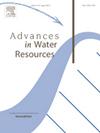Salinity effects on fines migration in aquifers: Stochastic model and its upscaling
IF 4
2区 环境科学与生态学
Q1 WATER RESOURCES
引用次数: 0
Abstract
Colloidal-suspension-nano flows with varying ionic strength are widely present in nature and industry. The variation of brine salinity, which highly affects electrostatic particle-rock interaction, triggers fines detachment and consequent rock alteration. The microscale models for fines detachment at the pore-particle and at rock-reservoir scales are widely used to predict core and field behaviour under fines migration, while the relationship between those models hasn't been established. This includes the lack of upscaling and downscaling procedures, which prevents the determination of micro-scale parameters from lab corefloods or well production histories and calculation of large-scale model functions from SEM and microfluid tests. In this work for the first time, we derive the rock-scale detachment model as expressed as a function of maximum attached concentration versus brine salinity (maximum retention function MRF) from particle-scale torque balance of attaching and detaching forces. Reflecting micro heterogeneity of the pore space and attached particles, we consider the mutual probabilistic distributions of geometric and electrostatic coefficients from the torque balance of detaching drag and attaching electrostatic DLVO forces exerting the particle. This determines the cumulative distribution of critical salinity, which is calculated from the torque balance and the mutual distribution of microscale parameters and defines the salinity-dependent MRF. This upscaling procedure is performed by the Monte Carlo algorithm for MRF calculation. The corresponding downscaling comprises tuning the mean and variance values for some micro-scale parameters from the MRF. These algorithms are used to treat three coreflood data sets with varying salinity, determine the MRF, and calculate mean values of lever arm and aspect ratios; the match is high, and the obtained microscale parameters are within the common intervals. The upscaling technique developed allows for sensitivity analysis of detachment with respect to microscale parameters and velocity. We also developed the upscaling procedure for MRF recalculation from dependency of one flow parameter to another. The velocity-dependent MRF was recalculated from three coreflood-based salinity-dependent MRFs, yielding lab-based prediction of well behaviour for water injectors and producers.
盐度对含水层中细粒迁移的影响:随机模型及其升级
具有不同离子强度的胶体-悬浮液-纳米流广泛存在于自然界和工业中。卤水矿化度的变化对静电颗粒-岩石相互作用有很大的影响,从而引发细粒剥离和随之发生的岩石蚀变。孔隙-颗粒尺度和岩石-储层尺度的细颗粒脱离微观模型被广泛用于预测细颗粒运移作用下岩心和场的行为,但两者之间的关系尚未建立。这包括缺乏放大和缩小尺寸的程序,这阻碍了从实验室岩心驱油或油井生产历史中确定微尺度参数,以及从SEM和微流体测试中计算大尺度模型函数。在这项工作中,我们首次从颗粒尺度的附着力和分离力扭矩平衡中推导出岩石尺度的分离模型,该模型表示为最大附着浓度与盐水盐度的函数(最大保留函数MRF)。考虑到孔隙空间和附着粒子的微观非均质性,我们从施加粒子的分离阻力和附着静电DLVO力的扭矩平衡中考虑几何系数和静电系数的相互概率分布。这决定了临界盐度的累积分布,由扭矩平衡和微尺度参数的相互分布计算得到临界盐度,并定义了与盐度相关的MRF。这个升级过程是由蒙特卡罗算法的MRF计算执行。相应的降尺度包括从MRF中调整一些微尺度参数的均值和方差值。这些算法用于处理三个矿化度不同的核心流体数据集,确定MRF,并计算杠杆臂和纵横比的平均值;得到的微尺度参数在常用区间内,匹配度高。所开发的升级技术允许对微尺度参数和速度的分离进行灵敏度分析。我们还开发了从一个流动参数依赖到另一个流动参数的MRF重新计算的升级程序。速度相关的MRF是由三个基于岩心流体的盐度相关MRF重新计算的,从而为注水井和采油井提供了基于实验室的井动态预测。
本文章由计算机程序翻译,如有差异,请以英文原文为准。
求助全文
约1分钟内获得全文
求助全文
来源期刊

Advances in Water Resources
环境科学-水资源
CiteScore
9.40
自引率
6.40%
发文量
171
审稿时长
36 days
期刊介绍:
Advances in Water Resources provides a forum for the presentation of fundamental scientific advances in the understanding of water resources systems. The scope of Advances in Water Resources includes any combination of theoretical, computational, and experimental approaches used to advance fundamental understanding of surface or subsurface water resources systems or the interaction of these systems with the atmosphere, geosphere, biosphere, and human societies. Manuscripts involving case studies that do not attempt to reach broader conclusions, research on engineering design, applied hydraulics, or water quality and treatment, as well as applications of existing knowledge that do not advance fundamental understanding of hydrological processes, are not appropriate for Advances in Water Resources.
Examples of appropriate topical areas that will be considered include the following:
• Surface and subsurface hydrology
• Hydrometeorology
• Environmental fluid dynamics
• Ecohydrology and ecohydrodynamics
• Multiphase transport phenomena in porous media
• Fluid flow and species transport and reaction processes
 求助内容:
求助内容: 应助结果提醒方式:
应助结果提醒方式:


